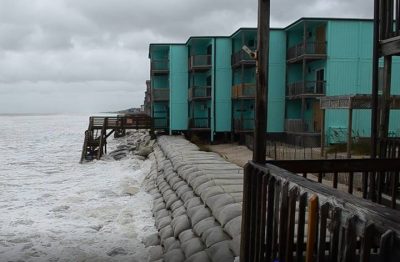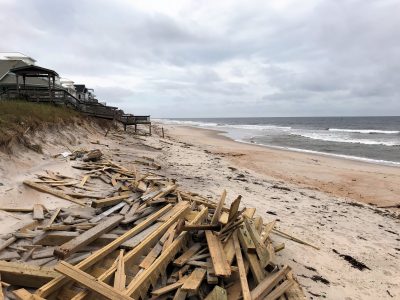
SURF CITY – Picking their top three? Easy enough.
The process that will follow, whether it’s fair, that each town gets a cut of the money, and that the towns, not outside influences, get the upper hand in deciding which storm mitigation projects get selected – this is where things could get tricky.
Supporter Spotlight
Topsail Island towns have narrowed the lists of projects each would like to see funded through a multi-million-dollar state grant awarded last year to Resource Institute, a Winston-Salem-based nonprofit.
In all, nine projects the towns are eyeing come with an estimated price tag well above the $5 million earmarked specifically for storm mitigation projects on the island.

Resource Institute, or RI, is asking for a 12 percent cut, or $600,000, of the Division of Water Resources grant for administrative costs to cover grant management, project management, technical assistance and oversight over the life of the project, according to a statement from the nonprofit’s board chairman Squeak Smith.
That leaves $4.4 million in the pot for projects that range in estimated price from $60,000 to $5 million.
“RI’s standard administrative cost when working with state, federal and private entities is 12 to 15% depending on project complexity, and we are certain the work on Topsail Island will be complex,” Smith said in the statement.
Supporter Spotlight
The towns of North Topsail Beach, Surf City and Topsail Beach initially submitted more than 20 projects to the institute for consideration.
Since January, town officials have pared down the number of proposed projects – three per town – to submit to a task force chaired by an RI representative with five voting members. Those voting members include one sitting member of each town board, a representative of RI and North Carolina Coastal Federation Executive Director Todd Miller.
Just how the projects will be ranked, selected and carried through were met with some apprehension and several questions from town managers and elected officials, who discussed the possibility of setting up in the future an emergency funding source, perhaps through the state, that the towns could tap into directly in the immediate aftermath of a storm.
“So that we’ll get full benefit,” said Topsail Beach Commissioner Steve Smith, who also chairs the Topsail Island Shoreline Protection Commission.
RI has done some work on coastal projects, but a majority of the nonprofit’s work has historically dealt in inland stream- and wetlands-restoration projects.
For that reason, some at the meeting March 5 suggested the institute rethink its system for ranking projects on the coast, where the window to work on shorelines is dictated by environmental-related factors such as turtle nesting season.
There’s also the time in which it takes to get Coastal Area Management Act, or CAMA, permits necessary to do shoreline projects such as the one North Topsail Beach has elected as its top priority project.
“You can’t even schedule your interagency meetings in 60 days, much less get a permit,” said Chris Gibson, president TI Coastal, a coastal engineering firm that routinely heads projects on the island.
North Topsail Beach leaders placed dune restoration at the top of their list of projects to be considered by the task force.
“We feel like we need to get our dune restored,” said town Alderman Mike Benson.

The town suffered an estimated $22 million loss of sand from the dune system stretching along North Topsail’s 11-mile shoreline during at Hurricane Florence, which hit the North Carolina coast last September. Later that same month, the remnants of Hurricane Michael swept away more sand from the island’s already battered beaches.
In a memorandum to RI, North Topsail Town Manager Bryan Chadwick explains that the town cannot financially replace all the sand. But, with some funding, about 100,000 cubic yards of sand could be placed along 6 miles of the dune line within the Coastal Barrier Resources Act, or CBRA, shoreline portion of the town’s beachfront.
CBRA was created in the early 1980s to discourage building on relatively undeveloped barrier islands. Areas designated CBRA do not receive federal funding and financial assistance.
Benson said it will cost the town an estimated $5 million to restore the dune line along about a 6-mile stretch of beach within the CBRA zone.
“Obviously we’re not going to get it with this one funding source,” he said, referring to the grant.
The town also placed among its three top priorities the installation of Hatteras ramps, which are wooden ramps that provide vehicle access to the beach, and planting vegetation to stabilize the dune berm.
“We need to protect our residential property, our town’s infrastructure, our tax revenue,” North Topsail Beach Mayor Dan Tuman said. “The dune is our shoreline defense. That’s the first thing we do.”

The town’s immediate neighbor to the south, Surf City, is currently working on its own post-Florence dune restoration project, which has a price tag of about $18 million.
The town would like to put grant money toward stormwater infiltration and improvements, Surf City Town Manager Ashley Loftis said.
Topsail Beach, the town on the southern end of the island, would also like to focus on stormwater improvements, with the top project being the installation of emergency stormwater pumping infrastructure.
There are seven areas within the town that experience the worst flooding during coastal storms and heavy rains, Town Manager Mike Rose said.
“From my end, stormwater management’s got to rank high for us,” he said.
The estimated costs associated with installing the pumping infrastructure total $140,000. Another estimated $60,000 would be need to place mobile emergency stormwater pumps to use at the flood-prone areas.
The town’s third-highest-ranking project is the development and installation of living shorelines and marsh sills along the sound side at potential public access sites. The estimated cost for those is up to $1 million.
Each project proposal the towns submit to the task force will be ranked by several factors, including the timeline a project will be “shovel ready,” that project’s overall impact on the town, and its environmental impact.
Smith pointed out that other groups, including the federation, will submit proposed projects to the task force, a prospect that drew criticism Tuesday during the meeting.
“You people probably know better than anybody else what’s best for Topsail Island,” Tuman said.
Rose said that, while he wasn’t sure the projects the towns are submitting to the task force benefit collectively all three towns, “I do feel this group in here now understands it.”
“Beyond these walls, that may be a different question,” he said.
To be completely fair, each town should get an equal cut of the grant funds and determine how to best use that money, Gibson said.
“There’s going to be some balancing,” Smith said. “It’s just a matter of how we flow through it and how we get that common ground to get things done correctly. We’ve got to make sure we know what makes a difference and what’s best for the island.”
Projects prioritized by the task force have to be submitted to the state by Oct. 1.







